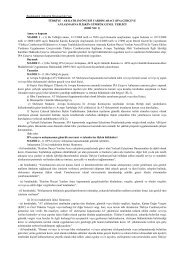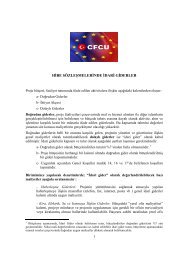Project Cycle Management Training Handbook - CFCU
Project Cycle Management Training Handbook - CFCU
Project Cycle Management Training Handbook - CFCU
You also want an ePaper? Increase the reach of your titles
YUMPU automatically turns print PDFs into web optimized ePapers that Google loves.
22<br />
An aid to<br />
thinking<br />
<strong>Project</strong> <strong>Cycle</strong> <strong>Management</strong> <strong>Training</strong> <strong>Handbook</strong><br />
Garbage-in;<br />
garbage-out!<br />
The logframe should thus not be seen as simply a set of mechanistic<br />
procedures, but as an aid to thinking. The logframe must also be seen<br />
as a dynamic tool, which should be re-assessed and revised as the<br />
project itself develops and circumstances change. It should be used to<br />
provide structure and purpose to project planning and budgeting<br />
without being perceived as an inflexible and constraining blueprint.<br />
By bringing stakeholders together during the analysis phase, to<br />
discuss problems, objectives and strategies, the LFA encourages<br />
people to consider what are their own expectations, and how these<br />
might be achieved. By stating objectives clearly and setting them out<br />
in a ‘hierarchy of objectives’, it then provides a means of checking the<br />
internal logic of the project plan, ensuring that activities, results and<br />
objectives are linked. Planners are forced to identify the critical<br />
assumptions and risks that may affect project feasibility, and to<br />
specify the indicators and sources of information that will be used to<br />
monitor and evaluate the project. All of this key information is<br />
brought together in one document that provides a useful summary.<br />
While the LFA has proven to be a useful planning and management<br />
tool, it is not a comprehensive tool and does not guarantee project<br />
success. The process is time-consuming and requires considerable<br />
training in the concepts and logic of the approach. Planners are<br />
required to summarise complex ideas and relationships into simple<br />
phrases that may be unclear or meaningless. All too often the<br />
caricature “fill-in-the-boxes” approach is used to complete the<br />
logframe matrix during project design, leading to a poorly prepared<br />
project with unclear objectives and a lack of ownership of the project<br />
among stakeholders.<br />
The Logframe itself consists of a table, or matrix, which has four<br />
columns and (in its most basic form) four rows. The vertical logic<br />
identifies what the project intends to do, clarifies the causal<br />
relationships and specifies the important assumptions and<br />
Add your own notes here…





